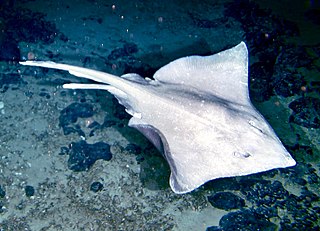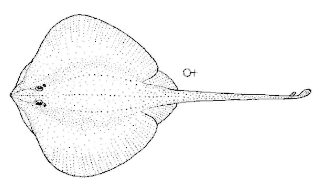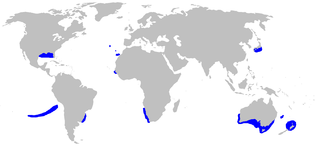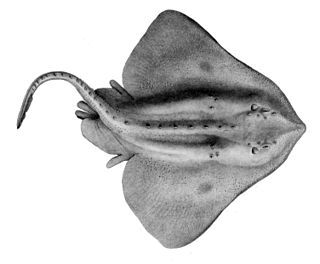
The longsnout dogfish is a little-known deepwater dogfish, found in the Atlantic and Indian Oceans from Namibia to Mozambique and in the South Pacific off southern Australia and New Zealand.

The New Zealand smooth skate is a skate of the genus Dipturus, found around New Zealand at depths between 15 and 1,300 m.

The New Zealand rough skate, Zearaja nasuta, is a skate of the genus Zearaja, found around New Zealand at depths between 10 and 1,500 m. Its length is up to 1 m. This species has been assessed by the IUCN as of Least Concern. In June 2018 the New Zealand Department of Conservation classified the New Zealand rough skate as "Not Threatened" with the qualifier "Conservation Dependant" under the New Zealand Threat Classification System.

Richardson's ray is a skate of the family Arhynchobatidae, found in the Atlantic Ocean and around Cook Strait in New Zealand, at depths of from 1,300 to 2,500 m. Their length can reach 1.75 m. Dorsal and ventral surfaces of the disc are uniformly covered with dermal denticles, but lack thorns on the disc. The tail has 18 moderately sized thorns.

The prickly deep-sea skate, or spinydeep-sea skate, is a deep sea skate in the family Arhynchobatidae. It lives off New Zealand, at depths of from 170 to 1,400 m on the continental shelf. Their length is from 60 to 80 cm.

The longtail skate is a skate and is the only member of the genus Arhynchobatis. This species was first described by Edgar Ravenswood Waite in 1909. It is found off New Zealand at depths of from 90 to 1,000 m on the continental shelf. Its length is from 30 to 75 cm.
The narrownose chimaera is a longnose chimaera of the family Rhinochimaeridae, the longnose chimaeras, consisting of eight species belonging three genera. This species is found in temperate seas worldwide, at depths between 200 and 3,100 m. Its length is between 1.0 and 1.5 m, including a long, tapering snout and a long, filamentous tail.
The New Zealand catshark is a catshark of the family Scyliorhinidae in the order Carcharhiniformes. This species is endemic to in the deep waters around New Zealand. Its length is up to 45 centimetres (18 in). The New Zealand catshark is a small, little-known deep water bottom shark. It is dark brown around the top with a few widely spaced pale spots, and white below. It feeds on bottom-living crustaceans. It is also completely harmless to humans.

The longnose velvet dogfish is a sleeper shark of the family Somniosidae, found circumglobally in southern hemisphere subtropical seas, at depths of between 230 and 1,500 m. It reaches a length of 130 cm. It has a diet consisting of predominantly mesopelagic fishes and squids.

The roughskin dogfish is a sleeper shark of the family Somniosidae, found around the world on continental shelves in tropical, subtropical and temperate seas, at depths of between 100 and 1,500 m. It reaches a length of 121 cm.

The spotted estuary smooth-hound or rig is a houndshark of the family Triakidae, found on the continental shelves and in estuaries around New Zealand. It is closely related to the gummy shark of Australia. Males can grow up to a length of 125 cm, while females can reach a length of 151 cm.

McMillan's catshark is a catshark of the family Scyliorhinidae, in the order Carcharhiniformes. McMillan's catshark is a small, rare, and little-known deepwater shark that is endemic to New Zealand. It is found at depths of 985–1350m on the lower continental slope around New Zealand, on the West Norfolk Ridge, and off North Cape. It can grow to a length of 45 cm.

The smooth lanternshark or slender lanternshark is a species of dogfish shark in the family Etmopteridae, found widely in the Atlantic and Pacific Oceans. It inhabits benthic environments at a depth of 274–1,000 m (899–3,281 ft), and pelagic environments at a depth of 0–708 m (0–2,323 ft). The smooth lanternshark forms a species group with the larger blurred lanternshark, both of which are distinguished from other members of their family by small, irregularly arranged dermal denticles with a truncated shape. This species has a slender, dark brown body with an indistinct black band on the sides over the pelvic fins, and reaches 50 cm (20 in) in length. This slow-growing, ovoviviparous shark feeds on smaller squid, fishes, and fish eggs. Smooth lanternsharks are often caught as bycatch in eastern Atlantic and Japanese commercial fisheries. The International Union for Conservation of Nature (IUCN) has evaluated this species as of Least Concern because of its wide distribution and limited threats.

The bulldog catshark is a catshark of the family Scyliorhinidae, found in the deep waters of the East China Sea and in the Northwest Pacific. In New Zealand waters it is found at the Reinga Ridge, the West Norfolk Ridge, the Hikurangi Trough and the Chatham Rise as well as on the Campbell Plateau.

The southern lanternshark is a shark of the family Etmopteridae found in the southeast Pacific between latitudes 29°S and 59°S, at depths of between 220 and 1,460 m. This species has been found off Northland, off the Chatham Islands, on the Campbell Plateau, all in New Zealand waters. Its length is up to 60 cm. Reproduction is ovoviviparous, with 10 to 13 pups in a litter, length at birth about 18 cm. They exhibit bioluminescence.
The leopard chimaera, Chimaera panthera, is a species of fish in the family Chimaeridae endemic to New Zealand. Its natural habitat is open seas. This species is considered rare and any specimens obtained should be sent to the New Zealand National Fish Collection at the Museum of New Zealand Te Papa Tongarewa.

The Arctic skate is a species of fish in the family Rajidae. It lives near the seabed between 140 and 2,500 m deep in the Arctic Ocean and waters around Canada and northern and north-western Europe, in the northern Pacific Ocean, and in waters surrounding Antarctica and New Zealand.
Brochiraja is a genus of deep-sea skates in the family Arhynchobatidae containing eight species. They are found in the waters around New Zealand and the Tasman Sea.
Garrick's catshark is a species of shark in the family Scyliorhinidae found in the waters of New Zealand. Its natural habitat is the open seas. The new deep-water catshark, Apristurus garricki, is described from the waters of northern New Zealand. It is named in honour of Jack Garrick.
The longnose deep-sea skate is a large skate in the family Arhynchobatidae. It was first described in 1985 from specimens collected near New Zealand. It is known to be a deep-water skate, however lack of research trawls at depths past 1500 meters limits knowledge of the depths where the species can be found. The species is dark brown or grey, with an eponymous elongated snout. The species has been measured to be a maximum of 140 cm in total length, although size variation and growth patterns are not known.















